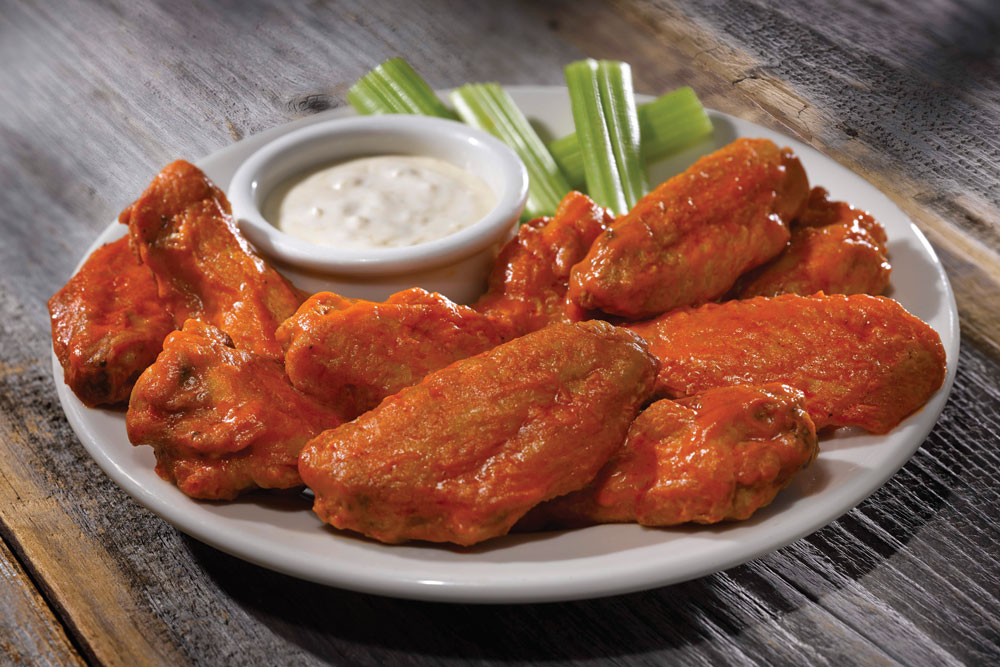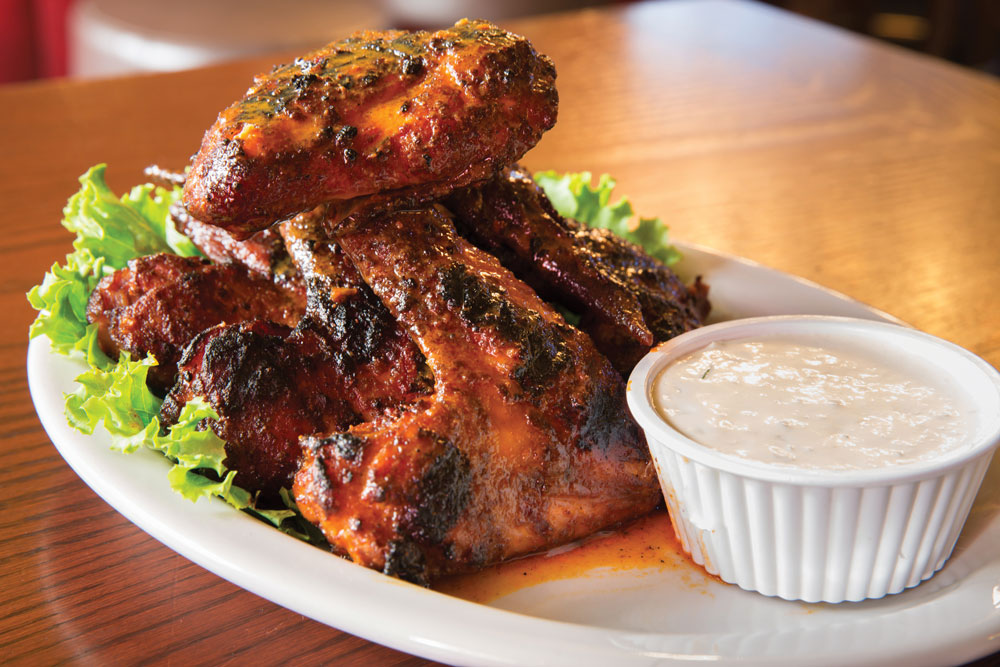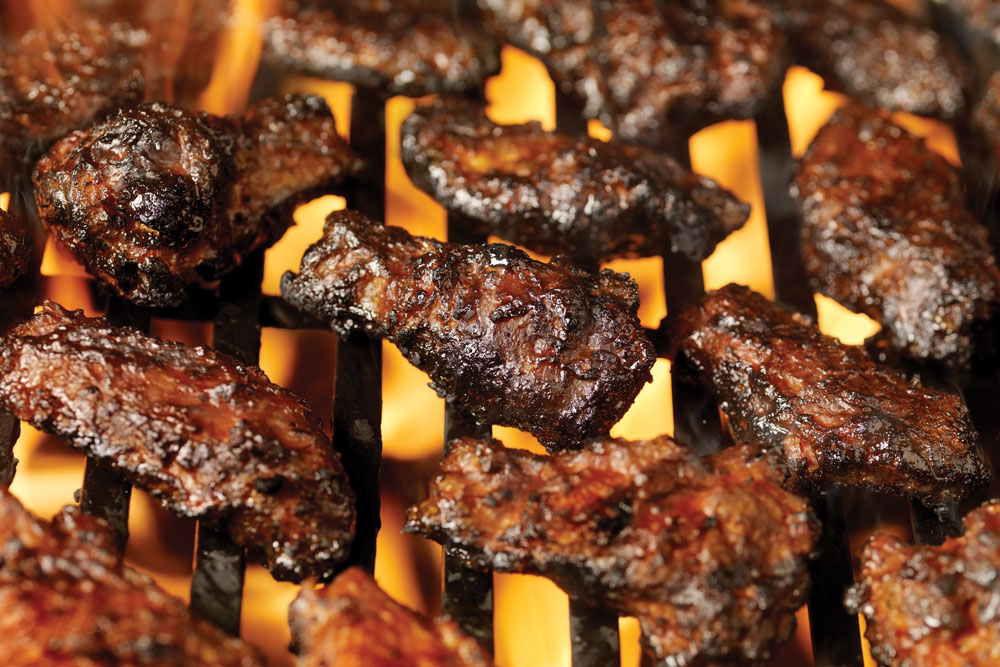Behold the lowly chicken! She may not be the smartest beast in the barnyard, but nearly every part of this domesticated dirt-scratcher’s plump little body tastes finger-lickin’ good, including her otherwise useless wings. If you need proof that chicken wings are still “flying” off the shelves in foodservice spots around the country, check out these stats: According to the National Chicken Council, more than four in five U.S. adults (81%) eat chicken wings, adding up to 28 billion wing portions sold in 2014, with more than 1 billion consumed on Super Bowl day alone.
Pizzeria operators helped pioneer this plucky path, offering wings to pair with their pizzas. But while your wings may be successful with the traditional sauces and sides (think buffalo with ranch or blue cheese), there is a vast world of flavors you can tap into. Just as you strive to make unique specialty pizzas that stand out from competitors, it’s worthwhile to think outside the buffalo box. Spread your wings, and sales will soar!
 |
|
Sauces, dips and marinades take chicken wings from ordinary to extraordinary—and allow for customer customization. OLD CHICAGO PIZZA & TAPROOM |
From Ordinary to Outstanding
Chicken wings offer a blank canvas for culinary creativity, notes Angie McGowan from Eclectic Recipes, speaking on behalf of the National Frozen and Refrigerated Foods Association. “I like to use homemade dry rubs with some spices and herbs: salt, pepper, paprika, garlic powder and Italian-herb seasoning,” she says. “And kids love sweet sauces for wings.”
Spices can be a healthy—and flavorful—way to jazz up a platter of chicken wings, so experiment with different spice blends or combine your own blends that evoke Southwest, barbecue or Asian flavors. “Chicken is such a great base for a lot of exciting flavor profiles,” says Paul Fishman, co-founder and chief marketing officer at Ground 2 Table, a San Diego-based spice company. Fishman has made wings with everything from a classic mesquite barbecue blend with a brown sugar twist to a curry powder marinade accompanied with a cucumber yogurt dipping sauce made with a seafood blend.
“Chicken wings are such a versatile dish, it’s very easy to turn them from ordinary to outstanding,” confirms Derrick Morgan, manager at Firehouse Tavern (firehousetavern.com) in New York. “The great thing about chicken wings is that you can try different recipes at once. Just two pounds can produce four different versions to pick and choose from.” For example, Morgan says, mixing different sauces is an easy way to change up your wings—or try playing with the level of heat. At Firehouse, the Bubba wings combine medium-heat buffalo sauce and barbecue sauce. And don’t forget accompaniments—they can also help make chicken wings more memorable. The wings at Firehouse are served with dressing with chunks of blue cheese, but you can also offer dressings with unique ethnic-inspired flavors, like Jamaican jerk or African peri-peri.
Fishman agrees that flavors are all about mixing and matching—the spice of curry pairs perfectly with the coolness of lemongrass and savory dill of a seafood blend, while an all-purpose blend (either classic or spicy) can be paired with a fun Chinese five-spice aioli for East-meets-West flair. Spices and herbs can also complement marinades; jazz up a sriracha aioli with a spicy blend, or mix mayo with curry powder for an easy curried mayo, Fishman suggests. For a healthy alternative to ranch dressing, infuse spices into Greek yogurt, topped with a squeeze of lemon and a dash of sea salt. Or try a spiced mole dipping sauce paired with spicy Latin-inspired wings.
At Broomfield, Colorado-based CraftWorks Breweries & Restaurants, which owns Old Chicago Pizza & Taproom (oldchicago.com), sauce selection has expanded to extend the traditional offerings of its classic Firehouse, Applewood BBQ and Buffalo Wings flavors. “We now use some cool dry rubs and wet sauces,” says Stan Frankenthaler, chief officer of food, beverage and strategic supply. “I personally crave our Italian Garlic and Herb. Also popular with our guests is our new Thai Fire.”
If you already offer unique specialty pies, chances are you can use your most successful combinations to inspire wing flavors—and potentially cross-utilize ingredients to keep costs down.
 |
|
Ethnic spices and flavor combinations offer something new for customers to try. VIRGIL'S WINGS |
Grilled, Fried or Twice-Cooked
As far as when to add spices during the marinating process, Fishman believes the earlier, the better. “Spices, unlike fresh herbs, take more time to open up and deliver flavor, so adding spices at the beginning of the marinating process, or giving them time to open up by adding them to the butter or oil you’re heating in the pan before you add your other ingredients, is key,” he notes. “We’re all about adding more spices than you would think you need, so save a bit for the cooking process—and, by all means, if it needs more, don’t deny your taste buds and add away. Get comfortable with flavor!”
You can also get creative with your method of preparation. “We like to bake wings in the oven at a lower heat (325° to 350°) to get a crispier wing,” McGowan says. For a healthier option, she steams wings in a steamer basket first, then cooks them in the oven, which helps draw the moisture out of the fat.
Grilling or frying works, too. At Slice of Vegas Pizza (sliceofvegas.com) in Las Vegas, a monthlong promotion this year proved a hit thanks to wings dipped in a wet batter, fish-and-chips style. These Swag Wings were based on a secret Twin City recipe that melded the flavors of Southern fried chicken with the spicy wings of the North. Fried chicken wings remain Slice of Vegas’ top-selling appetizer year-round, thanks to a range of flavors customers can sample: BBQ, medium, hot, atomic, jerk or garlic Parmesan.
Twice-cooked chicken wings come out crispy and crunchy while retaining their interior moisture, Frankenthaler believes. “You can consider a few options,” he says. “Most brands fry twice, which leads to crispy wings and is the most traditional approach. Or you can first slowly fry at a lower temperature, then allow the wings to cool before the second cook. After the wings are chilled, place them into a hot fryer.”
At Old Chicago, most wings are baked, then fried. “Cooking the wings slowly will allow them to cook fully while remaining moist,” Frankenthaler says. “The skin should not get very browned in the first round but will begin to crisp in the second cook. Then we always toss our sauces or spice blends on the wings hot out of the fryer.”
For a different approach, Frankenthaler recommends making a flavorful poaching liquid—ideal with Asian flavor profiles, for example. Slow-poach the wings on the first cook, which drives flavor into the wings. Then drain well and chill them before the second cooking. For a second cook, try grilling the wings. “You will get a different crispiness, of course,” Frankenthaler says. “But the char and smoky flavors add an interesting dimension.”
Whatever spices, marinades and cooking methods you use, experts agree: Wings allow for endless experimentation. “The most exciting thing about wings is that the opportunities to customize your meals are really endless,” concludes Fishman. “With wings as a canvas, there is really no flavor that is off limits!”
|
Mozambiquan Chicken Wings With Peri Peri Sauce
|
|
Provided by Chef Uma Naidoo, NeuroSpices, Cambridge, MA Wings:1 lb. chicken wings
Peri-Peri Dipping Sauce2 tbsp. vegetable oil
Instructions:Wash wings thoroughly and air-dry on a sheet tray in the refrigerator covered in plastic, or pat dry with paper towel. Season wings with salt, pepper, cayenne, garlic, cumin, coriander, and tamari or soy sauce. Add yogurt and mix well with spices. Refrigerate for about 3 hours or overnight to enhance the flavor. Bake in a 400° oven for 25 to 30 minutes or until wings are crispy and fully cooked. To make the dipping sauce, heat vegetable oil in a cast iron skillet, then add red onion, red peppers, garlic, chilies and curry leaves. Add red wine vinegar and allow to reduce. Cool the mixture, then puree in a blender. Season with salt and freshly squeezed lemon juice to taste.
Tip: If desired, add some Peri-Peri sauce to the wing marinade before baking. |















